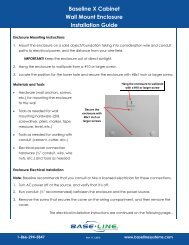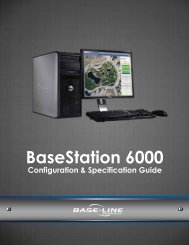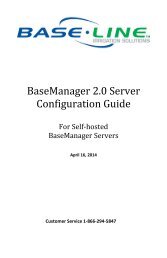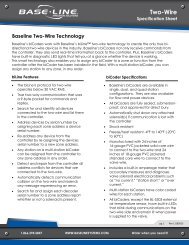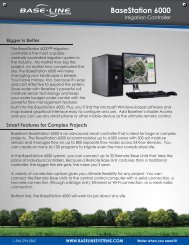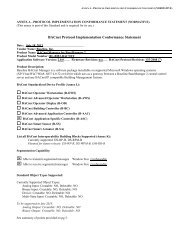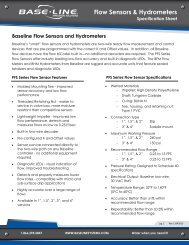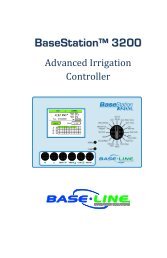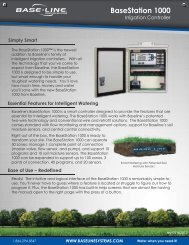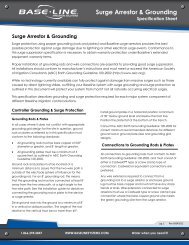©2011, <strong>Baseline</strong> Irrigation SolutionsOven Dry: When soil is dried in an oven, nearly all water is removed. This moisture content level isused to provide a reference for measuring and reporting volumetric soil moisture content (VMC). VMC isthe most common way to communicate a soil moisture point. If you dig up a volume of soil, weigh it,then cook it until it’s dry, and then weigh it again, the VMC is the percent of change in weight.Several terms are used to describe the water held between these different water contents. Gravitationalwater refers to the amount of water held by the soil between saturation and field capacity. Waterholding capacity refers to the amount of water held between field capacity and wilting point. Plantavailable water is that portion of the water holding capacity that can be absorbed by a plant. As ageneral rule, plant available water is considered to be 50 percent of the water holding capacity.Not All <strong>Soil</strong>s Are Created EquallyThe soil is the plant’s water and food supply. <strong>Soil</strong> is made up of mineral particles weathered out of rock.These particles are identified by their size as sand, silt, or clay. The mineral particles are held together byorganic matter. <strong>Soil</strong> is classified based on the relative proportions of sand, silt, and clay.Illustration from Discovery Educationhttp://school.discoveryeducation.com/schooladventures/soil/name_soil.htmlMost naturally occurring soils are a combinationof the various particle types (as illustrated in theUSDA soil texture diagram) plus organic material,gravel, rock, and plant material.When you look at soil, it appears that theparticles touch each other, but in reality there arespaces, called pores, in between. When soil is dry,the pores are filled <strong>with</strong> air, but after irrigation orrainfall, the pores fill <strong>with</strong> water. Water is alsoheld on the soil particles through adhesion andcohesion.<strong>Watering</strong> <strong>with</strong> <strong>Soil</strong> <strong>Moisture</strong> <strong>Sensors</strong>7 | P age
©2011, <strong>Baseline</strong> Irrigation SolutionsIn sandy soil, the individual sand particles are larger than those in clay soil. The sand particles fittogether in a way that creates large pores, but because the particles are large, there are fewer of themin a specified volume of soil, and the amount of total pore space is low. For these reasons, water movesthrough the large pores between the sand particles relatively quickly. Water adheres to the sandparticles, but because there are relatively few of them, the amount of water retained in the sandy soil islow.In clay soil, the pores between the particles are small, but because the soil particles are also small, thereare a large number of pores. Due to the greater number, the pores in clay soil can hold more water thanthe pores in sandy soil. And because there are more soil particles present, the amount of water adheringto those particles is greater than in a sandy soil. However, due to the small size of the pores and thelarge number of small soil particles, the clay soil holds the water more tightly than sand, andconsequently, the plant has to work harder to extract the water from the clay soil.In order to irrigate properly, you need to understand thecapacity of plant available water in your soil. Depending onthe predominate type of particles present in the soil, waterwill either penetrate and drain quickly (as in coarse-texturedsoil made up largely of sand) or water will penetrate anddrain slowly (as in fine-textured soils made up largely of siltor clay). However, even if you have your soil properlyidentified by a qualified soil lab, there are still many factorssuch as compaction, soil depth, layering, or slope thatcomplicate the ability to estimate plant available watercapacity. The <strong>Baseline</strong> soil moisture sensor makes thisprocess much easier by simply measuring the moisturecontent in the soil.Textural Class Plant Available WaterHolding Capacityinches/foot of soilCoarse sand 0.25 – 0.75Fine sand 0.75 – 1.00Loamy sand 1.10 – 1.20Sandy loam 1.25 – 1.40Fine sandy loam 1.50 – 2.00Silt loam 2.00 – 2.50Silty clay loam 1.80 – 2.00Silty clay 1.50 – 1.70Clay 1.20 – 1.50Table from Plant and <strong>Soil</strong> Sciences eLibrary – University of Nebraskahttp://passel.unl.edu/pages/informationmodule.php?idinformationmodule=1130447039&topicorder=10&maxto=10&minto=1Infiltration and Water MovementWe have briefly discussed the different water holding characteristics of soils. You also need to be awareof infiltration and how water moves <strong>with</strong>in the soil. While the details of this complex topic are based onphysics and soil science, there are a few high-level concepts that will help you make good day-to-dayirrigation decisions.The soil’s infiltration rate is the rate at which the soil is able to absorb water. As water is added to thesurface, it begins to work its way down in to the soil. Some soils can accept water much more quicklythan others. For example, consider what happens when you dip a paper towel into water. At first, thewater moves very quickly into the paper towel, and then it slows down and eventually appears to stop.This example demonstrates the effect of saturation on capillary action. The same thing happens in thesoil when water is first applied to the surface — it fills the soil pores nearest the surface first, and asthese pores fill up, the water moves deeper into the profile. The time it takes for water to move throughthe soil depends on the size of the spaces and pores between the soil particles.If you are trying to achieve your number one goal of “using the least amount of water possible to keepthe soil moisture content in the root zone between field capacity and maximum allowed depletion,” youneed to ensure that the applied water is making it to the root zone of the plant.<strong>Watering</strong> <strong>with</strong> <strong>Soil</strong> <strong>Moisture</strong> <strong>Sensors</strong>8 | P age
- Page 1 and 2: © 2011 by Baseline Inc.
- Page 3 and 4: ©2011, Baseline Irrigation Solutio
- Page 5: ©2011, Baseline Irrigation Solutio
- Page 10 and 11: ©2011, Baseline Irrigation Solutio
- Page 12 and 13: ©2011, Baseline Irrigation Solutio
- Page 14 and 15: ©2011, Baseline Irrigation Solutio
- Page 16 and 17: ©2011, Baseline Irrigation Solutio
- Page 18 and 19: ©2011, Baseline Irrigation Solutio
- Page 20 and 21: ©2011, Baseline Irrigation Solutio
- Page 22 and 23: ©2011, Baseline Irrigation Solutio
- Page 24 and 25: ©2011, Baseline Irrigation Solutio
- Page 26 and 27: ©2011, Baseline Irrigation Solutio
- Page 28: ©2011, Baseline Irrigation Solutio



